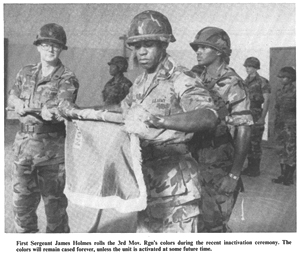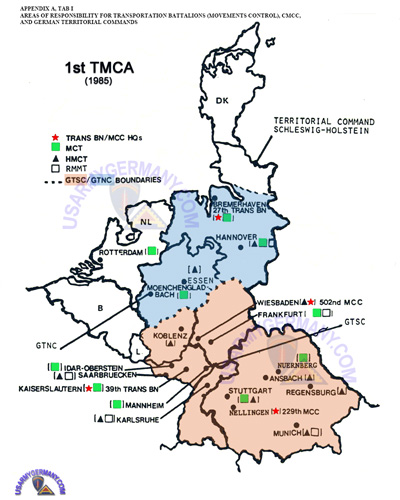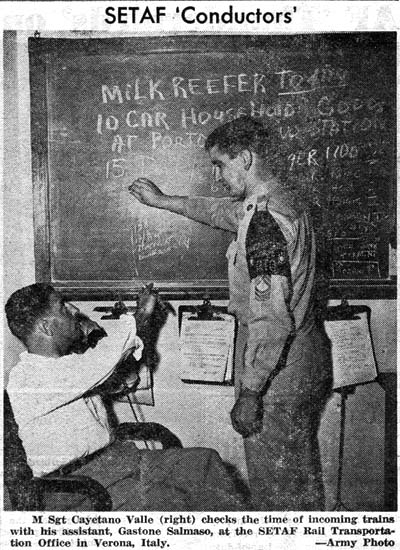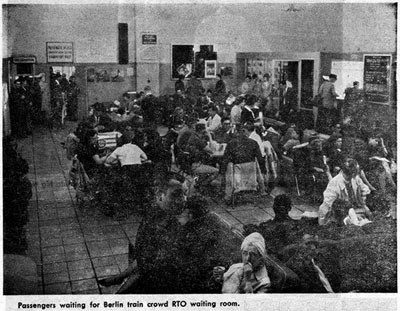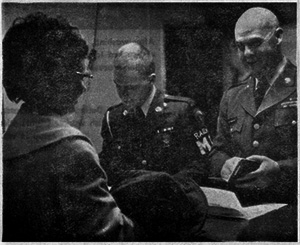| If you do
NOT see the Table of Contents frame to the left of this page, then
Click here to open 'USArmyGermany' frameset |
||||
1st Theater Movement Control Agency |
||||
|
|
||||
|
||||
|
|
||||
| 594th Transportation Group (Movement Control) | ||||
| 1958 | ||||
| (Source: The Transportation Movement System in USAREUR - 1958, report prepared by the Stanford Graduate School of Business, Stanford University, for the US Army Transportation Research Command, Fort Eustis, VA, 1958) | ||||
| This group (Org chart above) consists of a headquarters unit at the Transportation Office, COMZ, and regional and district offices widely dispersed in France and Germany to provide liaison with transportation officers of all US military installations, commercial carriers, and the French Army. The present positioning of the subordinate elements in France is influenced by an inefficient long-distance commercial telephone system which requires a greater disbursal of personnel than might be necessary if communications were adequate. The assigned unit mission is to: |
||||
| (Source: Email from Jon D. von Gunten, 594th Trans Gp (MC), 1958-60) | ||||
| I was stationed in Frankfurt from February, 1958 in the IG Farben Building in the RTMO and then transferred to Mainz in the TMO. Subsequently, was transferred to the DTMO in Bremerhaven and set up passenger trains for troops and dependents to the interior of Germany and France. Rotated back to the States in May 1960 as an Sp5 and would love to hear from anyone with similar history or in the same outfit.
FRANKFURT MAINZ BREMERHAVEN Sometimes we would have as many as five trains carrying troops and dependents from arriving troop ships in Bremerhaven to interior Germany. I remember some of those MSTS ships being named after Generals: Butner, Buckner, Darby Rose, Patch and Upshur. Hope you find this info interesting and valuable. |
||||
|
|
||||
| US Transportation Management Agency, Europe | ||||
| Movement Control Agency, Europe | ||||
| 1975 | ||||
| (Source: Email from Tim Moriarty, Berlin Duty Train, 3rd Mov Rgn, 1975) | ||||
| 3rd Movement
Region I stumbled across your website and thought I'd add what I could regarding railway guard MP operations in Germany. While I wasn't an MP, I worked with them for quite some time. When I arrived in Germany in mid-1975, I was assigned to HQ 3rd Movements Region, a part of the 4th Transportation Brigade, and I lived at the old Gutleut Kaserne, a ten-minute walk from the Frankfurt/Main Hauptbahnhof. I was on the side of the compound facing the tracks (north side), and I recall seeing the sign for the 570th MP Platoon (Railway Guard) on the opposite (south) side of the compound. I never had any direct contact with them, however, since I was a Berlin Duty Train conductor and the MPs with which I worked came out of the 287th MP Co, a part of the Berlin Brigade. Perhaps at one time a predecessor to the 570th worked the Berlin trains, but by that time the duty fell to those assigned within the 287th, perhaps because the 570th had been reduced to only a platoon. At the time the train crews consisted of a conductor, a train commander, a radio operator, an interpreter (for dealing with the Russians at the border) and a radio operator. All but the conductors were from the Berlin Brigade, and there was an effort to get those slots transferred as well. That finally happened in late 1976, when the remaining 4th Trans Bde conductors came off the rails and the Berlin Brigade put their own people in the jobs. It was really a "political" move not based on any specific requirement. The rail MPs from the 287th would ride the Frankfurt-bound night trains from Berlin to Frankfurt and, after the morning arrival, walk the short distance to Gutleut Kaserne. The 709th MP Bn provided them with a rather bare room with two bunks and two wall lockers. The MPs riding on the much smaller Berlin-Bremerhaven trains only rode as far as the border station at Helmstedt. There they'd step off and ride back to Berlin a short time later on the Bremerhaven-Berlin train. My conductor duty would take me to Berlin one night, Bremerhaven the next, and back to Frankfurt the third. On other nights I'd go to Bremerhaven the first night, Berlin the second, and then back to Frankfurt. The MPs were usually E3s and E4s on their first hitches. So was I, but all of the other conductors, with one exception, were E6s and E7s. (The one exception was an E5 who'd been around for quite some time.) We conductors stayed in billeting in Berlin and Bremerhaven and received TDY pay while on the road. The MPs did not. Unfortunately this resulted in a lot of resentment toward me from the MPs, who were getting shafted in comparison. The other conductors tended to dislike my presence as well, since the duty was seen as a real "get-over" for E6s and E7s only, and as a youngster I was clearly undeserving. (Ugh.) I was lucky enough to have the right MOS (65J - railroad brakeman/conductor) but I'm sure they would have preferred to have seen me assigned to a rail yard somewhere. In addition to the passenger trains, the MPs also rode the periodic military freight trains in and out of Berlin. Occasionally one of those trains and mine would pause near one another in the same East German rail yard, late at night. They rode in a two-axle caboose, an example of which is on display at the Fort Eustis, Virginia, Transportation Corps Museum. The museum's brochure says the caboose was used for passenger trains, but that was certainly not the case when I was there. The MPs didn't like them since they weren't heated well, if at all, and were uncomfortable. On the Duty Train we rode in a combination passenger-baggage car in which there were separate compartments for the German train conductor, the train commander (O-2 or O-3 - only rode between Helmstedt and Berlin), the Russian language interpreter, the MPs (together in one room) and myself. While escorting freight trains they wore fatigues, but when they rode the Duty Trains they wore Class As in the winter and khakis in the summer, as did I. When I first arrived in mid-1975 my roommate was a black E4 supply clerk named Kelly, who lived with his German girlfriend a few miles away downtown but maintained a room in the barracks. Reportedly he'd spent 90 days in Coleman Stockade in Mannheim when he was caught with drugs, and when he was released he and some friends thought they knew who fingered Kelly and that person soon turned up dead. I should add that the mid-1970s timeframe was a very drugged-up and sometimes dangerous period in the Army, a time the Army would probably prefer to forget. Within months of my arrival, Kelly reached his ETS and left. My new roommate, Frank, was also no stranger to drug usage and told me he bought his drugs (like Kelly) across the compound at the 709th, saying, "They use the law to beat the law." As I said, it was a very drugged-up time for the Army. Gutleut Kaserne closed in October 1976 and all of the units moved out to other locations in the area. I don't recall where the MP units went. I returned to Germany in September 1984 as an Air Force officer at Hahn Air Base, 90 minutes to the west, and I stopped by Gutleut to see what was still there. The former MP buildings on the south side had been cleaned up and sandblasted, but the other buildings housing the 21st Replacement Battalion, the NCO Club, the mess hall, gym and post theater were all gone. I hope this information is helpful to your website. Good work! Tim Moriarty |
||||
|
|
||||
| 1st Movements Region | ||||
| 1984 | ||||
| (Source: Transcommunicator, April 1984) | ||||
| Two junior soldiers take over at TMO Bremerhaven By P. Majcherek It was a normal day at the Transportation Movements Office in Bremerhaven, except for two exceptional soldiers, Sp4 Denita Price and Sp4 Jill Powell. The difference today was a new title temporarily taken in hand by the two soldiers. Price became acting chief and Powell became acting NCOIC. The two soldiers were appointed by the TMO's Chief, Capt. Charles Guta and NCOIC, SFC Tillman Henderson, with the idea that much could be learned from the actual experience gained as chief and NCOIC for a day. The final outcome would be a better understanding and appreciation for the complexities and responsibilities as a transportation movements manager. Price and Powelll had quite a day ahead of them. The two soldiers had to foresee and take charge of assigned personnel (one officer, 19 enlisted personnel and four local nationals). The operational functions of these 24 people include directing transportation movements and cargo within assigned boundaries, monitoring movement of commercial seavans maintaing liaison with mililtary and civilian transportation agencies and furnishing advice and guidance in transportation matters to other military agencies and commercial carriers. Along with those functions, TMO Bremerhaven conducts technical assistance visits to field installations to determine compliance with and adequacy of military traffic regulations. Liaison is also maintained between US and host nations to process movement clearances for outsize or overweight shipments, convoys, or cargo with special handling requirements. All these functions are shared by five unit sections to varying degrees: Outbound Cargo, Inbound Cargo, Containers, TMIPS, and the Field Movements Office at Hannover. In addition to performing operational functions during the day, the TMO must satisfy transportation requests from four major customers: Military Traffic Management Command, the Installation Transportation Office at Bremerhaven, the 2nd Armored Division, and Berlin. To satisfy movements requests, other military agencies must be notified. Those include the 4th TRANSCOM, the Motor Transport Clearance Authority, 37th Transportation Group, and other movements regions within the European theater. Price and Powell did not let those missions and functions bother them. The two soldiers performed their duties in an outstanding manner. They showed other members of the TMO that they could function under direct pressure and make the right decisions when they must be made. The exercise was not only a learning process for the two soldiers, but also for the other members of the TMO, who watched and trusted their actions and final decisions. They did not let anyone down, every detail was covered with expertise, confidence, and excellent soldiering. At the end of the day, Price and Powell were sitting in silence, pondering over the day's activities. When asked what they thought of their eventful day as chief and NCOIC, Price remarked "There were just too many meetings!" Powell laughed and added: "It was challenging because I had to make my own decisions." But they both agreed that it was an educational experience on how operations at the TMO really occur. Who will be next to take charge as acting chief and NCOIC? Since this program will be implemented every other month, two members of TMO Bremerhaven will know the answer to that question within 60 days. |
||||
| 2nd Movements Region | ||||
| 19.. - 1986 | ||||
| (Source: 27th Transportation Battaion, Online unit history, Briggs Library and Information Center, Fort Eustis, VA) | ||||
| Establishment of a Transportation Battalion Headquarters in Europe In the early-1980’s the United States Army Europe (USAREUR) recognized its readiness shortfalls in the movement control arena. The needs were identified in the USAREUR Transportation Operational and Organizational Plan or TROOP. One of the most sweeping organizational changes was the conversion of table of distribution and allowances (TDA) movement control teams to modified table of organization and equipment (MTOE) movement control teams. Additionally, TROOP identified the need to have adequate headquarters to command and control several subordinate movement control teams and highway regulating teams. The TROOP plan proposed that two of the three existing movement region headquarters under 4th TRANSCOM convert to MTOE 55-500 Team AD (Battalion Headquarters) with an assigned MTOE 55-580 LD Team (Movement Control) to serve as the movement region operation center. As TROOP was implemented in 1986, the existing 2nd Movements Region, located at Rhein Ordnance Barracks, Kaiserslautern, Germany, was converted from a TDA to an MTOE organization. The 2nd MR had three subordinate movement control teams in Kaiserslautern, Mannheim, and Idar Oberstein; three Highway Regulating Teams in Karlsruhe, Saarbruecken, and Koblenz; and two Rail Movements Offfices in Karlsruhe and Saarbruecken. While USAREUR was implementing the necessary changes to the movement control organizational structure in the mid-1980’s, US Army TRADOC and the United States Army Transportation Center was concurrently studying movement control doctrine and identified similar requirements needed throughout the Army. One of the outcomes was to establish transportation battalion headquarters as the basis for command and control over movement control teams. In early 1985, it was determined that the 2nd Movements Region Headquarters would be renamed the 39th Transportation Battalion. Officially, on 16 February 1986, after 14 years on inactive status, the 39th Transportation Battalion (Movement Control) was reactivated at Rhein Ordnance Barracks assuming the mission of the 2nd Movements Region. |
||||
| 3rd Movements Region | ||||
| 1980 | ||||
| 1984 | ||||
| (Source: Transcommunicator, March 1984) | ||||
| Phone, telex key to 3rd Mov. By Collie Murphy Its hard to believe that the movement of every piece of cargo and mail in southeastern Germany can be controlled over the phone or by telex, but that is exactly what the men and women of the 3rd Movements Region do. The 3rd Mov. Rgn., located in an industrial district in Frankfurt, is one of Europe's three active movement regions, providing transportation and traffic management support in their area of responsibility. |
||||
|
||||
| Moving freight into, out of, and within the state of Hessen is the job of the TMO's Freight Branch. Inbound and outbound freight specialists like Sp4 Douglas Moir, Sp4 Denise Knight, and Sp5 Ronald Cuffy keep track of and coordinate just about everything that moves. According to SSgt. Ervin Colon, NCOIC of the freight section, that means getting a print-out telling the weight and size of the incoming cargo, and to whom it's going. They then call the unit the cargo is destined for to let them know when to expect it. For outbound, it's done in reverse; ITOs call the two, telling them what needs to be moved where. From there, it's just a matter of contacting the Motor Transport Clearance Authority (MOTCA) in Kaiserslautern to turn that requirement into highway assets to pick up and deliver the cargo. Upstairs at the Movement Region headquarters Security, Plans, and Operations Section, planning for REFORGER is a full-time job, according to MSgt. James Holmes, SPO NCOIC. During the yearly exercise, the region meets the incoming troops, briefs them, arranges for transportation, and moves them to their final destination. The Region is located in a commercial facility in Frankfurt. This causes some problems, in that the nearest support facility is a half-hour away. To compensate, the unit has its own bus to transport troops to and from their billets and dining facility. |
||||
| (Source: Transcommunicator, Nov 1985) | ||||
| 3rd Mov. Rgn. inactivates By Lane Vance The 3rd Movements Region retired its colors Oct. 4, inactivating the unit, as its soldiers integrate into new parent organizations within the 4th Trans. Comd. as well as other commands. |
||||
|
||||
| 1st Theater Movement Control Agency | ||||
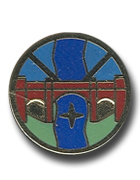 1st TMCA DI 1st TMCA DI |
||||
| 1985 | ||||
| (Source: Transcommunicator, Aug 1985) | ||||
| New plan rearranges some units Bx Lane Vance Some big changes are taking place in the 4th Trans. Comd's organizational structure. A Transportation Operational and Organizational Plan (TROOP) adopted by the Department of the Army in December 1984 has created the Theater Army Movements Control Agency at Camp King, disbands the 3rd Movements Region and organizes the remaining Movements Regions and 570th Military Police Platoon under the TAMCA. According to Tom Ogles, civilian traffic manager for the TAMCA, the most significant changes called for by the plan are changes in operational procedure. "We're changing the way we do business to reduce cost and to integrate current doctrine and USAREUR requirements," Ogles said. The new pIan was adopted from proposals drafted by members of the 4th Trans. Comd. and other organizations in Europe. The plan was drafted to correct shortfalls in wartime force structure and procedures, Ogles said. The new plan is designed to organize in peacetime to support wartime operations. Under the new plan, the TAMCA which has been designated the 1st Theater Army Control Agency, will act as a Commander-in-Chief United States Arm Europe, executive agent. This agency will control operations in the European movements control system, and resolve conflicts, planning, operational and procedural problems within the system. The agency will also exercise operational control over an theater transportation systems within USAREUR and manage movement branches and movement control centers and their subordinate movements control teams. TAMCA is currently operating under a provisional plan established in November of 1984. When the official change becomes effective on Feb. 17. 1986. the TAMCA will have a separate headquarters company but remain as part of the 4th Trans. Comd., Ogles said. The official plan also calls for changes in the organization of the Movements Regions and Installation Transportation Offices. 1st Movements Region will become the 27th Trans. Bn., and 2nd Movements Region will become the 39th (Trans) Bn. Each Installation Transporation Office will become a Branch Movements Control Team controlled by the Movement Control Teams in its respective area. Additionally, the Army Air Traffic Coordinating Office and Passenger Liaison Office will no longer operate under those titles. AATCO and APLO will now be Air Traffic Movements Control Teams. Coordination of Army passenger traffic and Department of Defense cargo forwarding operations will be controlled by these teams. According to Col. David Ostrom, executive officer of the TAMCA, other significant changes resulting from the plan are the disbanding of the 3rd Movements Region and the relocation of its equipment, personnel and responsibilities to other organizations within USAREUR. Transportation Movements Offices currently assigned to the 3rd Movements Region will be assigned to 502nd Movements Control Center, 3rd Support Command, V Corps, and TMO, Nuernberg and Stuttgart will be assigned to 229th Movements Control Center, 2nd Support Command, VII Corps. According to Maj. Leigh Blood, commander of the 3rd Movements Region, soldiers who work at headquarters are prepared to make the change. "Response from the staff here has been positive," Blood said. Blood commented that he remains confident that any problems associated with reassigning the staff from the Region's headquartes will be settled satisfactorily in time. Soldiers from 3rd Movements Region will not need to be reassigned. According to administrative specialist, Sp5 Charles Fraser, soldiers from Munich, Almsbach, Regensburg, Nuernberg, Stuttgartrt, Wiesbaden and Rhein Main Air Base will remain at their locations. "The soldiers will remain in place and continue in the same function, so the change will be a relatively small one for most of them. The primary adjustments for them will be administrative because soldiers in these areas will no longer be under the control of Headquarters, 3rd Movements Region," Fraser said. According to Fraser, the people who will be most affected by the change are the 25 soldiers who work in the headquarters in Frankfurt. Most of those soldiers will be reassigned to the TAMCA at Camp King, Fraser said. Fraser, who is one of the 25 soldiers to be reassigned said, "I think the people who will be reassigned are excited because they will be working in a larger organization than they are presently. |
||||
| 1986 | ||||
| (Source: Transcommunicator, May 1986) | ||||
| First TMCA activates during ceremony The 1st Transportation Movement Control Agency was officially activated April 8 during a ceremony at 4th Trans. Comd. headquarters, Camp King. Existing under various names since 1968, the elements which are now TMCA form a command "charged with the responsibility for a wide spectrum of transportation support throughout central Europe. Creation of the 1st TMCA is part of the Transportation Operational and Organization Plan designed to streamline transportation management," the activation ceremony program states. TMCA traces its history back to Dec. 2, 1968, when the U.S. Army Traffic Management Center and the 107th Traps. Bde. combined to form the U.S.Army Transportation Command, Europe (Provisional). The traffic management agency was redesignated the Transportation Movements Control Agency (Provisional). USATCE was later reorganized to include the 37th Traps. Gp., the Movements Control Agency, Transportation Terminal Group Europe, and the 205th Avn. Co. The Movement Control Agency, TMCA's predecessor, joined the 4th Trans. Comd. on July 1, 1974. First TMCA is composed of the 27th Trans. Bn., based in Bremerhaven, and the 39th Trans. Bn., Kaiserslautern. The 27th Trans. Bn. is responsible for transportation movement control in the Netherlands and the part of the Federal Republic of German under the German Territorial Northern Command. The 39th Trans. Bn. has similar responsibilities in Belgium, Luxembourg and that part of the German Territorial Southern Command which is not under V and VII Corps areas of operation. TMCA is commanded by Col. Thomas F. Young. |
||||
|
|
||||
| If you have more information on the history or organization of the Movement Control commands, please contact me. | ||||
(Source: Email from Thierry Rotty) |
||||
1st TMCA Organization (1986): |
||||
|
|
||||
| Rail Transportation Offices | ||||
| Source: STARS & STRIPES, Sept 21, 1956) | ||||
| Small
Office with a Big Job Verona RTO Keeps 'Em on Right Track By Henry B. Kraft, Staff Correspondent VERONA, Italy, Sept. 20 (Special) -- The SETAF Rail Transportation Office here is one of the busiest Army centers of its kind in Europe. This big job of routing thousands of Americans to their destinations annually is performed by a staff of only five persons. This energetic group works amid heaps of papers and well-thumbed European train schedules. They must be able to answer all kinds of questions almost immediately, sometimes without reference to schedules. Freight cars that arrive with gasoline for the POL, shipments of fresh meat and vegetables for Army messes, the many carloads of equipment for newly constructed SETAE facilities -- these represent just a small part of the supervisory functions of the tiny office in Verona, which is at the northern crossroads of Italy. Enthusiastic About Job When Americans get off the trains in Verona they immediately see the sign "SETAF - RTO" over the door of the transportation office and hasten inside for information. In some instances they are only seeking a chance to speak English to someone. MSgt Cayetano Valle, who is in charge of the RTO, is enthusiastic about his job. Since Italy is popular with military travelers his office is kept busy day and night, particularly when trains are due. |
||||
|
||||
| Even before the sleeper arrives from the south, a refrigerator car has arrived in the railroad yards with fresh milk from Austria. It is sidetracked by the RTO and its contents distributed to Army messes and commissaries in northern Italy. As the only English-speaking group at Verona's railroad station, Valle and his small staff are constantly confronted with new transportation questions which pour in from SETAF installations and as far south as Rome. But they always have the answers. |
||||
|
|
||||
| Source: STARS & STRIPES, May 11, 1963) | ||||
| Frankfurt
RTO: Keeping U.S. Travelers On Right Track By Odice McDaniel, Staff Writer LOCATING LOST husbands and children, assisting dependents in finding overnight lodging and providing information on local tourist attractions are some of the marginal services performed by Army rail transportation offices that are not covered in the manual. "There is more to this job than just keeping military travelers on the right track," says M Sgt John W. Auckerman of El Paso, Texas, NCO in charge of the Frankfurt RTO, "and a lot of it isn't in the transportation manual." |
||||
|
||||
| If a soldier has exhausted his money while on emergency or normal leave and needs a train ticket to return to his unit, the Frankfurt RTO issues him a ticket that is reimbursable to the government. Another of the official duties of the RTO is the inspection of the Frankfurt to Berlin, and Frankfurt to Bremerhaven trains carrying military personnel and their dependents. When the trains arrive at the station, two members of the RTO go through the passenger cars, checking to see it water fountains are operating properly, if windows will open and close easily, and if the compartments are clean. An RTO also is an A1 target for practical jokers -- "What time does the 8 o'clock train leave?" -- and that sort of thing. |
||||
|
||||
| NOTE: Read more about the Berlin Duty Train on R. W. Rynerson's web site: Berlin - 1969; and Bill McAllister's page: Berlin RTO. | ||||
|
|
||||
| Related
Links: Europe: The Second Front - very interesting article on the Military Sea Transportation Service in Europe; found on the excellent US Merchant Marine web site dedicated to veteran mariners of the U.S. Maritime Service, Army Transport Service, Military Sea Transportation Service, and Military Sealift Command. |
||||

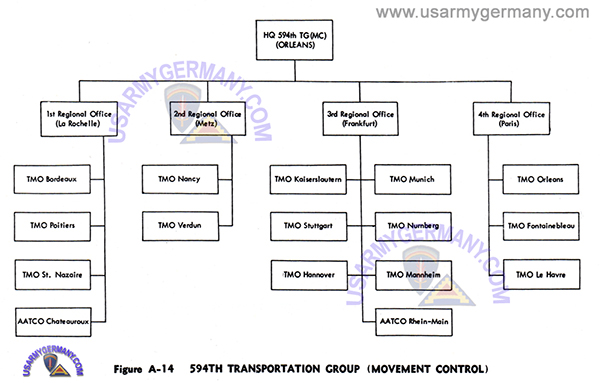
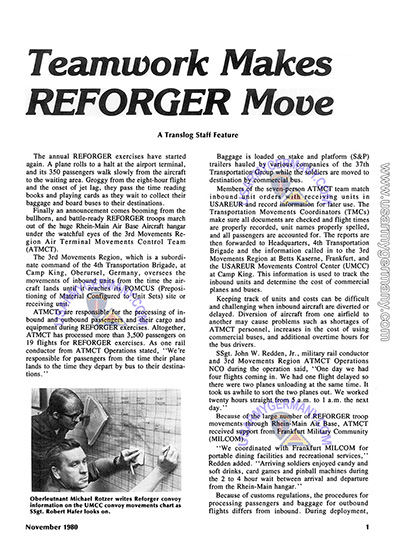
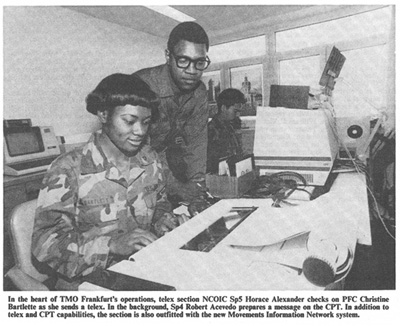
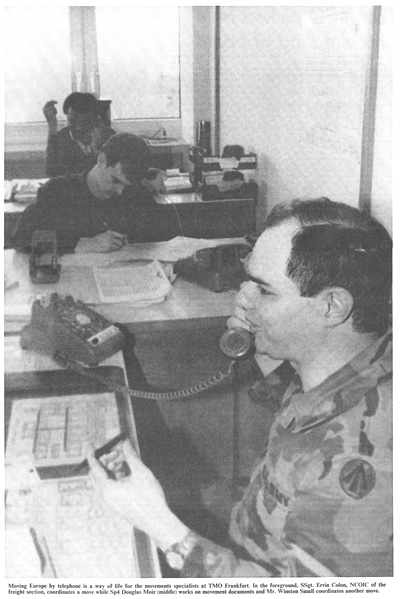 NCOIC, Freight Section SSgt Ervin Colon, coordinates a move by telephone. Sp4 Douglas Moir and Mr. Winston Small are visibile in the background.
NCOIC, Freight Section SSgt Ervin Colon, coordinates a move by telephone. Sp4 Douglas Moir and Mr. Winston Small are visibile in the background. 